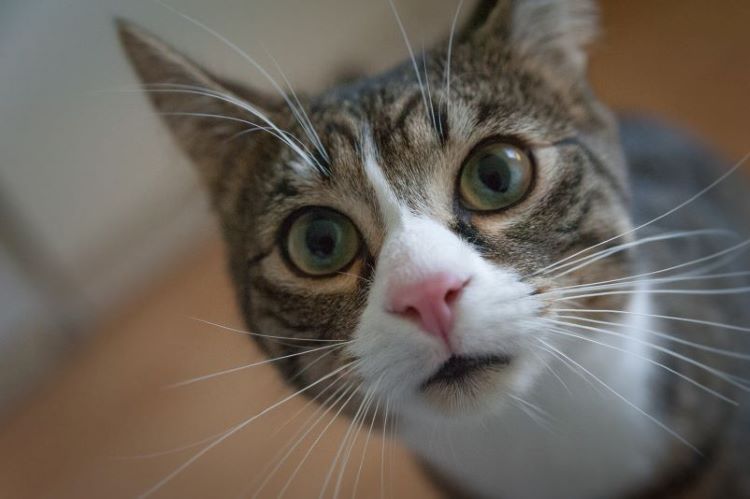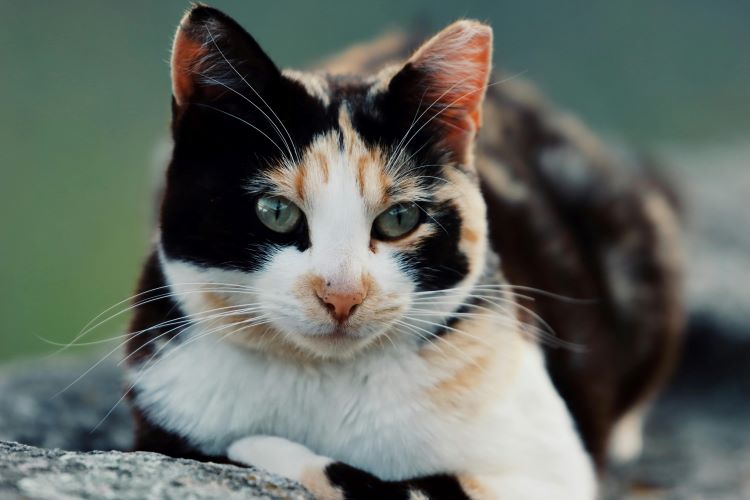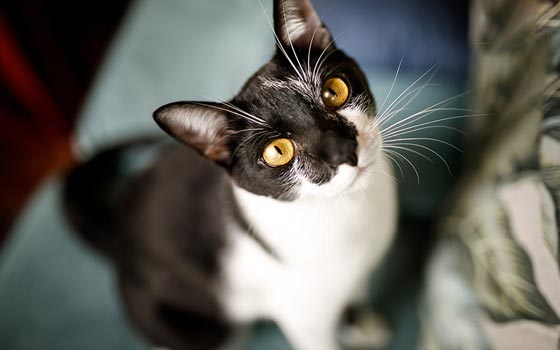Ready to help treat your pet to a healthy life?
What is a Mixed Breed Cat? A Lesson in Feline Diversity
By : Trupanion Staff | Updated Aug 8, 2024

If you're unsure of what kind of cat you have and they don't seem to fit any particular categorization, there's a good chance you're among the millions of pet owners around the world with a mixed breed. Mixed breed cats, often referred to as Domestic Shorthairs or Domestic Longhairs in North America depending on their coat length, are cats without a specific pedigree. These cool cats come in a wide range of colors, patterns, and temperaments, making each one unique. Unlike purebred cats, mixed breed cats have a diverse genetic background, which can contribute to a variety of physical traits and personality characteristics.
One of the main advantages of mixed breed cats is their genetic diversity, which often leads to better overall health and fewer hereditary issues compared to purebred cats. This genetic variation can make them less prone to certain breed-specific health problems, resulting in a longer and healthier life. Mixed breed cats are also known for their adaptability and resilience. They are commonly found in shelters and rescue organizations, making them readily available for adoption. By choosing a mixed breed cat, you not only gain a loving companion but also support animal welfare by giving a home to a cat in need.
Ready to learn more about these special kitties? Let's dive in with this breed guide, er, mixed breed guide.
Quick facts
- Kittens and cats of unknown lineage are commonly referred to as mixed breed or Domestic cats, further refined into categories based on length of fur: Domestic shorthairs, Domestic medium hairs, and Domestic longhairs.
- Just because a Domestic or mixed breed cat doesn’t have an official pedigree doesn’t mean you can’t show them! The International Cat Association (TICA) allows cat owners to show their non-pedigreed cat, with judging based on condition, beauty, and “show presence.” The World Cat Federation and the International Feline Federation allow housecats to compete in shows as well.
- Mixed breed cats are the most popular cat in the United States and are a good choice for new cat owners. However, Domestic Medium-haired cats are less common than the Domestic Shorthair and Domestic Longhair type cats.
- The long hair in mixed breed domestic cats is due to a recessive mutated gene, thought to have surfaced when cats needed warmer coats in the cooler European climates, around the 15th century.
Get to know mixed breed cats
Mixed breed cats have unknown mixed origins. As such, they can be found in any color, color combination, or pattern that is seen in other cat breeds, from Tabby to Tuxedo to Tortoiseshell and beyond!
Most often, their coloring and look trend toward the most common coloring and body style of other pedigreed cats in their geographical area. Mixed breed cats in Asia quite often have Siamese coloring, while mixed breed cats in the United States and the United Kingdom have a larger, sturdier body like the popular Shorthairs.
Temperament
In terms of personality, mixed breed cats can be just as affectionate, playful, and loyal as any purebred. Their diverse backgrounds mean that each mixed breed cat has its own unique set of traits, making them highly individualized pets. The mixed breed cat varies greatly in temperament and personality as a result, depending on their specific genetics and learning experiences. You’ll find all “types” of these domestic cats, which means there’s some kitty for everyone! In fact, they’re often the first cat for many owners, due to their prevalence in shelters and rescues. When choosing a mixed breed kitten or adult cat, make sure to look for a companion that fits in with your lifestyle.
Domestic mixed breed cats have varied lifestyle preferences. Some cats are content to lounge around with their human guardians with occasional short play sessions, some cats are independent and self-entertaining, and others are highly active, intelligent and require constant physical and mental stimulation. If you have a particular lifestyle you’d like to share with your furry friend, consider adopting an adult cat. Since they’ve already grown into their personalities, you can get a better sense of the lifestyle they’ll need. Kittens (as a general guideline) tend to be active and playful, but may mellow out or maintain their energy level as they get older — you never know what you’re going to end up with when you bring home a kitten! That’s part of the fun.
History
Mixed breed cats can be found all over the world, as they are simply cats of a long and mixed heritage. Throughout history, they’ve acted as workers and companions to their families. Arriving in America aboard the ships of the early settlers, including the Mayflower, mixed cats played an important role in the new world. They may have started out keeping rodents at bay for pioneers and shopkeepers but soon became a popular family pet.

Mixed breed cat behavior and training
Depending on your cat’s personality, they may get along well (or not) with other kittens, adult cats, household pets, and people. It’s always best to introduce your cat to a potential new friend slowly, giving them a choice whether or not to interact, and providing positive reinforcement for positive interactions. Introducing a dog to your cat may require extra finesse and patience.
Particular care should be taken when introducing cats to each other, as most cats require time to get to know a new feline companion. Introductions that are rushed can result in fighting or injuries, undesirable behaviors (such as house-soiling), and stress for both humans and animals.
Exercise and enrichment needs
Domestic cats need enough exercise to stay healthy and trim, as well as prevent unwanted behavior problems. Provide them with sufficient playtime, areas to climb, and encourage them to follow you around the house (or leash train them for outside walks) to get their steps in every day.
All cats require mental enrichment to keep their minds sharp and active. Boredom can cause stress, which results in behavior issues. To keep your kitty from getting bored, make sure you provide them with plenty of toys, rotated regularly, to keep them novel and exciting; plenty of perching places to climb and explore; cozy nooks in which to take naps; windows from which to watch wildlife; play (using an interactive wand toy) providing an outlet for their instinctive predatory behaviors; and puzzle-solving opportunities (such as food puzzles). Depending on how inquisitive, motivated, and intelligent your cat is, you might also consider clicker-training tricks and commands.
Common behavioral issues
While many mixed breed cats don’t exhibit behavior issues, they can crop up if cat guardians aren’t meeting the needs of their cat. Mostly commonly are house-soiling (especially if appropriate litterbox setups are not provided and maintained); inter-cat aggression (if a slow-introduction process is not followed); and destructive behavior such as scratching furniture, knocking over objects, and counter-surfing (particularly if ways to alleviate boredom are not provided). The potential for encountering these problems can be minimized or avoided by making sure your cats’ needs are being met. This means an appropriate place for elimination, territorial security, mental and physical exercise, and social interaction.
Cats are also known to exhibit behavioral issues or changes if they’re experiencing pain, discomfort or medical problems. So, it’s important to manage your kitty’s health with regular visits to the veterinarian (consider cat insurance to help with your pet's health care if you haven't done so already).
Fun activities for healthy cats
Mixed breed cats have a wide variety of preferences when it comes to fun activities. If your cat shows signs of fear, stress, or anxiety, discontinue the activity; start off small, and encourage the exploration of new objects and activities using positive reinforcement (treats, petting, praise, play, etc. — anything your cat enjoys). Have fun together while you try new things!
- Food puzzles of all difficulty levels. Start easy, and with a high-value treat. When your kitten gets the hang of things, increase the difficulty level and perhaps mix other food in with the treats. Many cats are even fed their meals using food puzzles and puzzle feeders!
- Play sessions with a wand toy are a MUST to keep your cat physically and mentally healthy. Use a long wand with interchangeable lures that resemble natural prey items - birds, rodents, snakes/lizards, and bugs. Some cats have preferences for certain types of prey, so don’t be afraid to switch lures to keep things exciting.
- Self-play toys such as small mice or balls that can be batted around. Even crumpled up pieces of paper and aluminum foil balls can be fun! But make sure you keep a close eye on playtime so toys don’t turn into snacks. Some cats (especially young kittens) will chew and can ingest things they shouldn’t. Don’t forget to rotate toys regularly to ensure that your cats don’t get bored.
- Vertical space! Provide plenty of places for your cats to explore, from cat trees to perches, and shelves. Keep kitty safe by securing these landing and launching pads to avoid falling and crushing injuries.
- Clicker-training can be a fun activity for smart cats. Try trick-training (commands like sit, roll-over, stationing, high-fives, etc.) or even building agility courses for cats to run through.
- Outdoor time can be great for cats, but only with the right precautions. If your cat enjoys the outdoors, give them a way to safely get out of the home by taking walks in a pet-stroller, teaching them to take walks with you wearing a harness/leash, or even building an enclosed catio.
- Cat TV time can provide extra stimulation indoors. Play videos of wildlife made specifically for cats that feature birds, squirrels, and other animals. Better yet, place bird and squirrel feeders outside of a window from which your cat can enjoy a live show.
- Heated cat beds will be appreciated in colder months, particularly for older cats (or any aged cat that has arthritis).
- Cozy escapes are essential for cats. Whether they're boxes, bags (with handles removed), cubbies, or a warm blanket, it's important to give cats privacy during nap times, or just a refuge from the dog or small child in the family.
Mixed breed cat grooming and care
Mixed breed cats can have a thick, double coat of short length (less than 1 inch long), medium length (1 to 2 inches long), or long length (more than 2 inches long).
All mixed breed cats need regular maintenance to keep their coats healthy. Weekly brushing (more during seasonal shedding periods) will help prevent matting and furballs in short and medium hair lengths, while daily brushing and more intensive grooming is needed for long-coated domestics. While most are quite capable of keeping themselves clean, sometimes a bath is in order. Like all cats, the mixed breed cat requires regular nail trimming and teeth brushing to stay happy and healthy.
While mixed breed felines are considered healthy overall thanks to their plentiful genetic diversity, this doesn't mean they're immune to health problems. Like all cats, they can face various health issues, from accidents to chronic conditions. Treatments for surprise veterinary costs can be very expensive, which is why it's a good idea to protect your pet with cat health insurance before any issues arise.

Mixed breed cats in pop culture
Mixed breeds encompass a wide range of cats. You've likely seen more than a few of them in art, media, and in the families of celebrities.
Famous owners of mixed breed cats
- Ian Somerhalder (Actor)
- Robin Lopez (Basketball Player)
- Alison Brie (Actress)
- Freddie Mercury (Singer)
- Kirsten Dunst (Actress)
- Crystal Dunn (Soccer Player)
- Ernest Hemmingway (Author)
- Eartha Kitt (Actress)
- Valerie Bertinelli (Actress)
Famous mixed breed cats
Mixed breed cats are especially popular on social media:
- Venus, the beautiful “two-faced” chimera cat
- Lil Bub
- Sam, the cat with eyebrows
- Bob, the street cat
